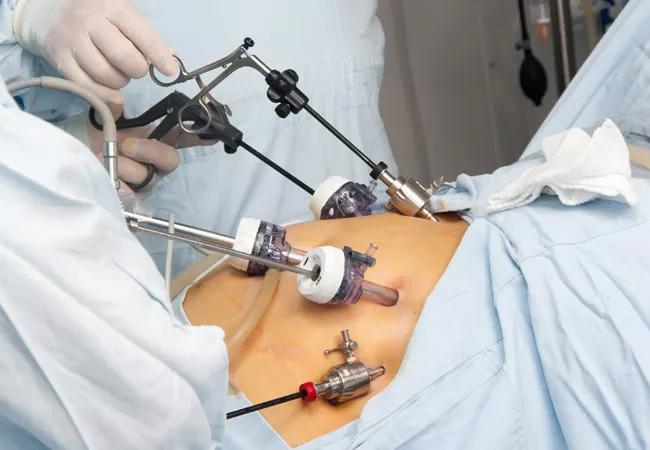Advertisement
Findings presented at WCOG at ACG2017

As rates of obesity have risen, so have the number of bariatric surgeries, making it one of the most common gastrointestinal (GI) operations worldwide. One of the most effective treatments for obesity, bariatric surgery not only promotes weight loss but also improves the management of diabetes, hypertension and metabolic disease. In 2015, Cleveland Clinic performed 655 bariatric surgeries, a number that is increasing each year.
Advertisement
Cleveland Clinic is a non-profit academic medical center. Advertising on our site helps support our mission. We do not endorse non-Cleveland Clinic products or services. Policy
Roux-en-Y gastric bypass (RYGB) is the most common bariatric surgery performed at Cleveland Clinic. Completing an RYGB operation involves re-routing the anatomy of the GI tract and the pathway food travels once ingested. The result is a small gastric pouch directly connected to the middle portion of the small intestine. Laboratory research has revealed that the positive effects of a gastric bypass operation are a result of more than just changes in anatomy — there are also profound changes in hormone and nerve signaling. These changes affect appetite, hunger and feelings of fullness, and alter the function of the pancreas, liver and bile ducts. They may also predispose patients to new morbidities.
Cleveland Clinic has developed expertise in techniques to evaluate and treat patients after bariatric surgery, since anatomical changes make it difficult to diagnose disease via routine endoscopy. The advanced procedures performed include endoscopic ultrasound (EUS) and laparoscopic-assisted transgastric endoscopic retrograde cholangiopancreatography (ERCP). Dilated bile ducts are a common indication for these procedures. When patients present with symptoms typical of diseases of the bile ducts, such as nausea, vomiting and pain in the right upper abdomen after eating, imaging studies are often ordered. Ultrasound, computed tomography (CT) or magnetic resonance imaging (MRI) may reveal dilated bile ducts, prompting further investigation with EUD and/or transgastric ERCP.
Some patients who have undergone transgastric ERCP at Cleveland Clinic had bile ducts that were dilated on imaging studies, but appeared relatively normal during ERCP, and specifically had no obvious cause for obstruction. It wasn’t clear if this symptom was due to surgery or an unrelated cause. Also, it wasn’t known whether this observation was specific to RYBG or followed any type of bariatric surgery.
To learn more about the relationship of bariatric surgery and bile duct diameter, Amit Bhatt, MD, led a team of Cleveland Clinic researchers that included members of the departments of General Surgery, Gastroenterology and Hepatology, Internal Medicine, and Diagnostic Radiology. Together, this multidisciplinary group and Quantitative Health Sciences, investigated whether a change occurs in common bile duct biliary diameter following RYGB and longitudinal sleeve gastrectomy (LSG).
The findings were presented this week at the World Congress of Gastroenterology at ACG2017 by Neal Mehta, MD, an internal medicine resident at Cleveland Clinic, from a study co-authored by Andrew Strong, MD, a general surgery resident at Cleveland Clinic.
The single center retrospective study assessed biliary diameter before and after RYGB and LSG based on ultrasound, CT or MRI. Common bile duct (CBD) diameter was measured at the same location both before and after bariatric surgery.
Advertisement
Study participants included 269 patients who had bariatric surgery (193 RYGB and 76 LSG) from January 2010 to December 2013 who had imaging studies before and more than three months after surgery. Patients with choledocholithiasis (gallstones in the common bile duct) and obstructive jaundice were excluded. The participants included 202 women and 67 men with a median age of 47 and median body mass index (BMI) of 46 kilograms per square meter. This group included 54 people who had a prior cholecystectomy, or gallbladder removal, a factor known to contribute to mild dilation of the common bile duct.
The results demonstrated that, after adjusting for pre-operative factors, subjects who underwent an RYGB had an increase in CBD diameter of 1.4mm (95% CI: 0.096 – 0.18), which was greater than the change following LSG 0.5mm (95% CI: – 0.007, 0.11). Biliary dilation occurred whether or not patients had previously undergone cholecystectomy.
“We will be managing more and more people with post-bariatric anatomy and we should be cautious in considering biliary dilation alone as a sign of bile duct pathology, and look for additional evidence before considering invasive procedures. We know that removing the gallbladder results in biliary dilation; the same may be true for bariatric surgery,” says Dr. Bhatt, the primary investigator and a gastroenterologist in the Department of Gastroenterology and Hepatology.
The research team is exploring the potential mechanisms causing bile duct dilation following bariatric surgery and considering the clinical implications of the finding. Current theories invoke some of the nerve and hormone signaling pathways altered after RYGB specifically; however, there appear to be other factors at play, since not every patient develops dilation to the same degree.
Advertisement
Advertisement

Insights from Cleveland Clinic’s Vice Chair of Innovation and Technology

Cleveland Clinic study finds that durable weight loss is key to health benefits

Findings could help promote organ preservation

A proof-of-concept study shows how 3D pouchography can be a useful adjunct for surgeons

The new appointee brings special expertise in hereditary and young-onset colorectal cancer

New research shows dramatic reduction in waitlist times with new technology

Potential for new, non-invasive screening option

Provider vigilance and patient education are key for management